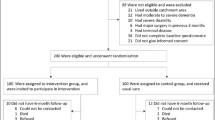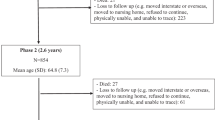Abstract
Objectives
Little is known about socio-economic differences in dietary intake among older adults. In this study we describe self-reported dietary adherence to the fruit, vegetables and fish guidelines among older Dutch adults and investigate the independent associations of three socio-economic status (SES) indicators with adherence to these guidelines.
Design
Cross sectional data-analyses.
Settings
The Longitudinal Aging Study Amsterdam (LASA), the Netherlands.
Subjects
1057 community dwelling older adults, aged 55–85 years.
Measurements
Fruit, vegetable and fish intake was assessed using a short food frequency questionnaire. We measured SES using self-reported levels of education, household income and occupational prestige.
Results
82.5% of the respondents reported to adhere to the fruit guideline, 65.1% to the vegetables guideline, and 31.7% to the fish guideline. After adjustment for confounders and the other two SES indicators, respondents in the lowest education group adhered less often to the vegetables guideline (OR 0.39 (95% CI 0.22–0.70)) compared to those in the highest education group. Respondents in the lowest income group adhered less often to the fruit (0.44 (95 % CI 0.22–0.91) and fish guideline (OR 0.55 (95% CI 0.33–0.91) compared to those in the highest groups. Occupational prestige was not independently associated with adherence any the guidelines.
Conclusion
Selfreported adherence to the fruit, vegetables and fish guidelines among older adults can be improved and particularly in those with a low SES. Education and income have independent and unique contributions to dietary adherence. Future research should investigate potential pathways through which these specific SES indicators influence dietary adherence.
Similar content being viewed by others
References
Mackenbach, J.P., et al., Socioeconomic inequalities in health in 22 European countries. N Engl J Med, 2008. 358(23): p. 2468–2481.
Marmot, M., et al., WHO European review of social determinants of health and the health divide. Lancet, 2012. 380(9846): p. 1011–1029.
Irala-Estevez, J.D., et al., A systematic review of socio-economic differences in food habits in Europe: consumption of fruit and vegetables. Eur J Clin Nutr, 2000. 54(9): p. 706–714.
Hulshof, K.F., et al., Socio-economic status, dietary intake and 10 y trends: the Dutch National Food Consumption Survey. Eur J Clin Nutr, 2003. 57(1): p. 128–137.
Touvier, M., et al., Variations in compliance with recommendations and types of meat/seafood/eggs according to sociodemographic and socioeconomic categories. Ann Nutr Metab, 2010. 56(1): p. 65–73.
Anderson, A.L., et al., Dietary patterns and survival of older adults. J Am Diet Assoc, 2011. 111(1): p. 84–91.
Zheng, J., et al., Fish consumption and CHD mortality: an updated meta-analysis of seventeen cohort studies. Public Health Nutr, 2012. 15(4): p. 725–737.
He, F.J., et al., Increased consumption of fruit and vegetables is related to a reduced risk of coronary heart disease: meta-analysis of cohort studies. J Hum Hypertens, 2007. 21(9): p. 717–728.
Alinia, S., O. Hels, and I. Tetens, The potential association between fruit intake and body weight—a review. Obes Rev, 2009. 10(6): p. 639–647.
Dauchet, L., et al., Fruit and vegetable consumption and risk of coronary heart disease: a meta-analysis of cohort studies. J Nutr, 2006. 136(10): p. 2588–2593.
Carter, P., et al., Fruit and vegetable intake and incidence of type 2 diabetes mellitus: systematic review and meta-analysis. BMJ, 2010. 341: p. c4229.
Soerjomataram, I., et al., Increased consumption of fruit and vegetables and future cancer incidence in selected European countries. Eur J Cancer, 2010. 46(14): p. 2563–2580.
Krieger, N., D.R. Williams, and N.E. Moss, Measuring social class in US public health research: concepts, methodologies, and guidelines. Annu Rev Public Health, 1997. 18: p. 341–378.
Galobardes, B., A. Morabia, and M.S. Bernstein, Diet and socioeconomic position: does the use of different indicators matter? Int J Epidemiol, 2001. 30(2): p. 334–340.
Turrell, G., et al., Measuring socio-economic position in dietary research: is choice of socio-economic indicator important? Public Health Nutr, 2003. 6(2): p. 191–200.
Waterlander, W.E., et al., Energy density, energy costs and income — how are they related? Public Health Nutr, 2010. 13(10): p. 1599–1608.
Drewnowski, A., Obesity and the food environment: dietary energy density and diet costs. Am J Prev Med, 2004. 27(3 Suppl): p. 154–162.
Darmon, N., A. Briend, and A. Drewnowski, Energy-dense diets are associated with lower diet costs: a community study of French adults. Public Health Nutr, 2004. 7(1): p. 21–27.
Drewnowski, A., et al., Low-energy-density diets are associated with higher diet quality and higher diet costs in French adults. J Am Diet Assoc, 2007. 107(6): p. 1028–1032.
McLeod, E.R., K.J. Campbell, and K.D. Hesketh, Nutrition Knowledge: A Mediator between Socioeconomic Position and Diet Quality in Australian First-Time Mothers. J Am Diet Assoc, 2011. 111(5): p. 696–704.
Malon, A., et al., Compliance with French nutrition and health program recommendations is strongly associated with socioeconomic characteristics in the general adult population. J Am Diet Assoc, 2010. 110(6): p. 848–856.
Giskes, K., et al., A multilevel study of socio-economic inequalities in food choice behaviour and dietary intake among the Dutch population: the GLOBE study. Public Health Nutr, 2006. 9(1): p. 75–83.
Moreira, P.A. and P.D. Padrao, Educational and economic determinants of food intake in Portuguese adults: a cross-sectional survey. BMC Public Health, 2004. 4: p. 58.
van Rossum, C.T., et al., Education and nutrient intake in Dutch elderly people. The Rotterdam Study. Eur J Clin Nutr, 2000. 54(2): p. 159–165.
Katsarou, A., et al., Socio-economic status, place of residence and dietary habits among the elderly: the Mediterranean islands study. Public Health Nutr, 2010. 13(10): p. 1614–1621.
Darmon, N. and A. Drewnowski, Does social class predict diet quality? Am J Clin Nutr, 2008. 87(5): p. 1107–117.
Brownie, S., Why are elderly individuals at risk of nutritional deficiency? Int J Nurs Pract, 2006. 12(2): p. 110–118.
Huisman, M., et al., Cohort profile: the Longitudinal Aging Study Amsterdam. Int J Epidemiol, 2011. 40(4): p. 868–876.
Planbureau, C., Modaal inkomen. http://www.cpb.nl/onderwerp/arbeidsmarkt (accessed June 2012). 2012.
Koster, A., et al., Explanations of socioeconomic differences in changes in physical function in older adults: results from the Longitudinal Aging Study Amsterdam. BMC Public Health, 2006. 6: p. 244.
Sixma, H. and W. Ultee, Een beroepsprestigeschaal voor Nederland in de jaren tachtig. Mens en Maatschappij 1983; 58:360–382. 1983.
Block, G., et al., A rapid food screener to assess fat and fruit and vegetable intake. American journal of preventive medicine, 2000. 18(4): p. 284–288.
Kim, D.J. and E.J. Holowaty, Brief, validated survey instruments for the measurement of fruit and vegetable intakes in adults: a review. Prev Med, 2003. 36(4): p. 440–447.
Gezondheidsraad, Richtlijnen goede voeding 2006 (Dietary Guidelines 2006) — Den Haag: Gezondheidsraad, 2006; publicatie nr A06/08.
Stel, V., et al., Comparison of the LASA Physical Activity Questionnaire with a 7-day diary and pedometer. J Clin Epidemiol. 2004 Mar;57(3):252–258, 2004.
Permanent Onderzoek Leefsituatie (POLS) 2005–2008. In: Volksgezondheid Toekomst Verkenning, Nationale Atlas Volksgezondheid. Bilthoven: RIVM, 〈http://www.zorgatlas.nl〉 Zorgatlasßeïnvloedende factoren/Lichamelijke eigenschappen, 8 april 2011.
Radloff, L., The CES-D scale: a self-report depression scale for research in the general population. ApplPsych Meas, 1997. 1, 385–401.
Berkman, L., C. Berkman, and e.a. Kasl S, Depressive symptoms in relation to physical health and functioning in the elderly. Am J Epidemiol, 1986. 124, 372–388.
Penninx, B.W., et al., Changes in depression and physical decline in older adults: a longitudinal perspective. J Affect Disord, 2000. 61(1–2): p. 1–12.
Knoops, K.T., et al., Mediterranean diet, lifestyle factors, and 10-year mortality in elderly European men and women: the HALE project. Jama, 2004. 292(12): p. 1433–1439.
Stanner, S. and A. Denny, Healthy ageing: the cardiovascular system. Healthy Ageing: The Role of Nutrition and Lifestyle. The Report of a British Nutrition Foundation Task Force, (S Stanner, R Thompson, JL Buttriss eds), pp. 159–190. Wiley-Blackwell: Oxford, 2009.
Davies, N., Promoting healthy ageing: the importance of lifestyle. Nurs Stand, 2011. 25(19): p. 43–49; quiz 50.
Rizzuto, D., et al., Lifestyle, social factors, and survival after age 75: population based study. BMJ, 2012. 345: p. e5568.
Turrell, G. and A.M. Kavanagh, Socio-economic pathways to diet: modelling the association between socio-economic position and food purchasing behaviour. Public Health Nutr, 2006. 9(3): p. 375–383.
Riediger, N.D. and M.H. Moghadasian, Patterns of fruit and vegetable consumption and the influence of sex, age and socio-demographic factors among Canadian elderly. J Am Coll Nutr, 2008. 27(2): p. 306–313.
Parmenter, K., J. Waller, and J. Wardle, Demographic variation in nutrition knowledge in England. Health Educ Res, 2000. 15(2): p. 163–174.
Hendrie, G.A., J. Coveney, and D. Cox, Exploring nutrition knowledge and the demographic variation in knowledge levels in an Australian community sample. Public Health Nutr, 2008. 11(12): p. 1365–1371.
Gasquet, I., et al., Construction of a questionnaire measuring outpatients’ opinion of quality of hospital consultation departments. Health Qual Life Outcomes, 2004. 2: p. 43.
Wall, J., et al., Effectiveness of monetary incentives in modifying dietary behavior:a review of randomized, controlled trials. Nutr Rev, 2006. 64(12): p. 518–531.
Blakely, T., et al., Do effects of price discounts and nutrition education on food purchases vary by ethnicity, income and education? Results from a randomised, controlled trial. J Epidemiol Community Health, 2011. 65(10): p. 902–908.
Estaquio, C., et al., Socioeconomic differences in fruit and vegetable consumption among middle-aged French adults: adherence to the 5 A Day recommendation. J Am Diet Assoc, 2008. 108(12): p. 2021–2030.
Rossum, C.T.M.v., et al., Dutch Food Consumption Survey 2007–2010, ed. R.R. 350050006/2011. 2011, National Institute for Public Health and the Environment.
Author information
Authors and Affiliations
Corresponding author
Rights and permissions
About this article
Cite this article
Dijkstra, S.C., Neter, J.E., Brouwer, I.A. et al. Adherence to dietary guidelines for fruit, vegetables and fish among older Dutch adults; the role of education, income and job prestige. J Nutr Health Aging 18, 115–121 (2014). https://doi.org/10.1007/s12603-013-0402-3
Received:
Accepted:
Published:
Issue Date:
DOI: https://doi.org/10.1007/s12603-013-0402-3




